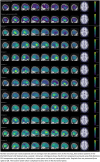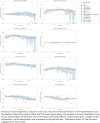Predicting Cognitive Functioning for Patients with a High-Grade Glioma: Evaluating Different Representations of Tumor Location in a Common Space
- PMID: 38900230
- PMCID: PMC11329426
- DOI: 10.1007/s12021-024-09671-9
Predicting Cognitive Functioning for Patients with a High-Grade Glioma: Evaluating Different Representations of Tumor Location in a Common Space
Abstract
Cognitive functioning is increasingly considered when making treatment decisions for patients with a brain tumor in view of a personalized onco-functional balance. Ideally, one can predict cognitive functioning of individual patients to make treatment decisions considering this balance. To make accurate predictions, an informative representation of tumor location is pivotal, yet comparisons of representations are lacking. Therefore, this study compares brain atlases and principal component analysis (PCA) to represent voxel-wise tumor location. Pre-operative cognitive functioning was predicted for 246 patients with a high-grade glioma across eight cognitive tests while using different representations of voxel-wise tumor location as predictors. Voxel-wise tumor location was represented using 13 different frequently-used population average atlases, 13 randomly generated atlases, and 13 representations based on PCA. ElasticNet predictions were compared between representations and against a model solely using tumor volume. Preoperative cognitive functioning could only partly be predicted from tumor location. Performances of different representations were largely similar. Population average atlases did not result in better predictions compared to random atlases. PCA-based representation did not clearly outperform other representations, although summary metrics indicated that PCA-based representations performed somewhat better in our sample. Representations with more regions or components resulted in less accurate predictions. Population average atlases possibly cannot distinguish between functionally distinct areas when applied to patients with a glioma. This stresses the need to develop and validate methods for individual parcellations in the presence of lesions. Future studies may test if the observed small advantage of PCA-based representations generalizes to other data.
Keywords: Cognitive functioning; Dimensionality reduction; High-grade glioma; Individual predictions; Lesion location; Parcellations.
© 2024. The Author(s).
Conflict of interest statement
The authors declare no competing interests.
Figures




Similar articles
-
Cognitive functioning early after surgery of gliomas in eloquent areas.J Neurosurg. 2012 Nov;117(5):831-8. doi: 10.3171/2012.7.JNS12263. Epub 2012 Aug 31. J Neurosurg. 2012. PMID: 22937930
-
Association between tumor location and neurocognitive functioning using tumor localization maps.J Neurooncol. 2019 Sep;144(3):573-582. doi: 10.1007/s11060-019-03259-z. Epub 2019 Aug 13. J Neurooncol. 2019. PMID: 31410731
-
Brain network topology and its cognitive impact in adult glioma survivors.Sci Rep. 2024 Jun 4;14(1):12782. doi: 10.1038/s41598-024-63716-2. Sci Rep. 2024. PMID: 38834633 Free PMC article.
-
Predicting post-surgical functional status in high-grade glioma with resting state fMRI and machine learning.J Neurooncol. 2024 Aug;169(1):175-185. doi: 10.1007/s11060-024-04715-1. Epub 2024 May 24. J Neurooncol. 2024. PMID: 38789843 Free PMC article.
-
Glioma surgery in eloquent areas: can we preserve cognition?Acta Neurochir (Wien). 2016 Jan;158(1):35-50. doi: 10.1007/s00701-015-2601-7. Epub 2015 Nov 14. Acta Neurochir (Wien). 2016. PMID: 26566782 Free PMC article. Review.
References
-
- Acevedo-Vergara, K., Perez-Florez, M., Ramirez, A., Torres-Bayona, S., Dau, A., Salva, S., et al. (2022). Cognitive deficits in adult patients with high-grade glioma: A systematic review. Clinical Neurology and Neurosurgery. 10.1016/j.clineuro.2022.107296 10.1016/j.clineuro.2022.107296 - DOI - PubMed
-
- Adewole, M., Rudie, J. D., Gbdamosi, A., Toyobo, O., Raymond, C., Zhang, D., Omidiji, O., Akinola, R., Suwaid, M. A., Emegoakor, A., Ojo, N., Aguh, K., Kalaiwo, C., Babatunde, G., Ogunleye, A., Gbadamosi, Y., Iorpagher, K., Calabrese, E., Aboian, M., Linguraru, M., … Anazodo, U. C. (2023). The brain tumor segmentation (BraTS) Challenge 2023: glioma segmentation in sub-saharan Africa patient population (BraTS-Africa). ArXiv, arXiv:2305.19369v1.
-
- Bakas, S., Reyes, M., Jakab, A., Bauer, S., Rempfler, M., Crimi, A., et al. (2019). Identifying the best machine learning algorithms for brain tumor segmentation, progression assessment, and overall survival prediction in the BRATS challenge. arXiv:1811.02629 [cs, stat]. http://arxiv.org/abs/1811.02629. Accessed 7 October 2020
-
- Banerjee, P., Leu, K., Harris, R. J., Cloughesy, T. F., Lai, A., Nghiemphu, P. L., et al. (2015). Association between lesion location and language function in adult glioma using voxel-based lesion-symptom mapping. NeuroImage: Clinical,9, 617–624. 10.1016/j.nicl.2015.10.010 10.1016/j.nicl.2015.10.010 - DOI - PMC - PubMed
MeSH terms
LinkOut - more resources
Full Text Sources
Medical

